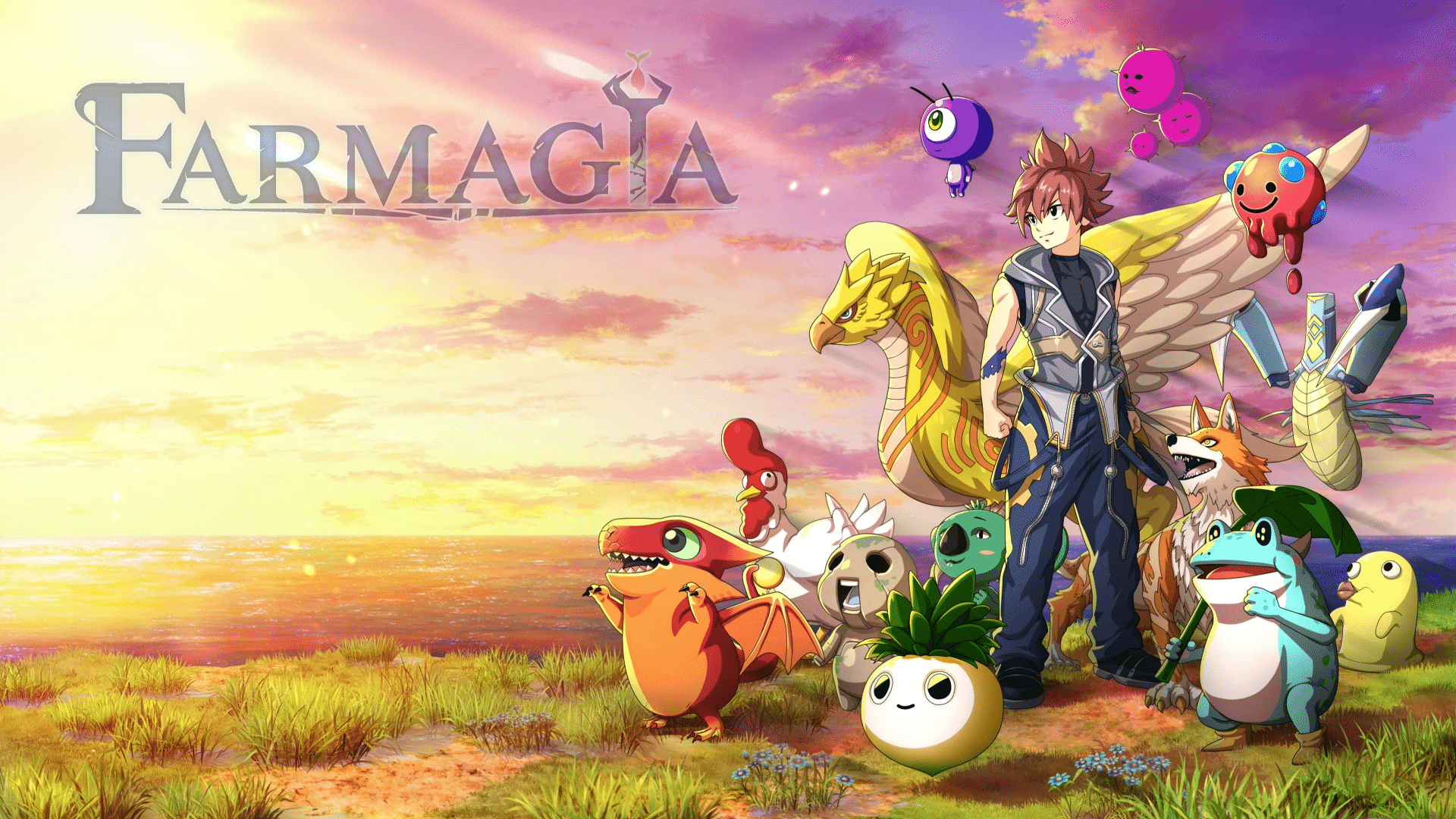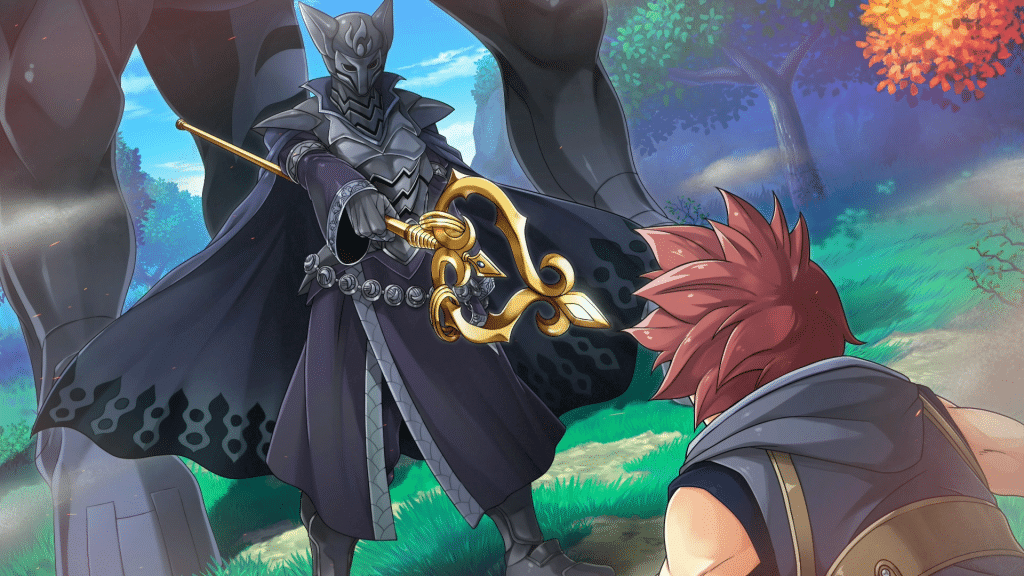

Those familiar with anime/manga likely recognized Hiro Mashima’s artwork the second Farmagia was shown. The main cast didn’t just resemble his style, it invokes an immediate connection similar to Toriyama, and Dragon Quest. While this is a strong selling point for a new franchise, it offered an interesting take on the farming genre. With established names dominating the space it’s a hard space to break into. However, armed with strong ambitions, and Mashima’s beloved art style, can it make a name for itself, or does it fall short of expectations?
Farmagia starts with a brief introduction to the world. Essentially, people there live with monsters, and those who can tame them are known as Farmagia. In this world there are a couple of islands, each lead by a general, and a single ruler above them all. His death resulted in a power vacuum. One of the leaders, Glaza, offered an optimistic vision; whereas Nares suggested he had nefarious ambitions, and rebelled against him.


With the main conflict in place, the narrative revealed the protagonist, Ten. The young Farmagia hopes to protect his nation from the incoming threat with his ever growing power. Aided by a powerful team, and a leader that refuses to back down, it sets the stage for bigger conflict than anyone could’ve expected.
Despite an interesting central conflict, Farmagia struggles to stand out. Most of the time it feels like a generic shonen series. High stakes are juxtaposed against humorous, and questionable interactions, lead by a protagonist that strikes first, and thinks never. As a result, gameplay needs to do the heavy lifting.
On paper Farmagia sounds quite robust. Players can interact with the town, work on a farm, support monsters via the ranch, or conqueror mazes. The reality is a lot of these concepts are underwhelming compared to what one might expect.
Take optional character interactions. Instead of having a town to explore, players are given a number of locations they can select. When choosing certain locations, such as Shuffling Sheep, there is another option to talk to the various people currently in the building. The most robust version of this can be found under Elemental Shrine. There players can give presents to the various Elementals to unlock events, and buffs.
Farming is one of the most rudimentary systems I’ve ever seen. Players start by tilling the land, planting seeds obtained through various means like killing monsters, and then watering them. Each seed can be harvested after a set number of days. Harvested monsters will give new allies, materials, unlock new forms, or give points that can be used to enhance the farming experience.
Surprisingly, Ranch is an even less impressive mode. Here players can increase monster levels by training them. Though, training is more like trading a resource for a set amount of stat points. Said amount is related to the monsters motivation, a stat that decreases with each training session, and increases by letting time pass, or simply bribing it with treats.
The final mode, Mazes, is more of a roguelike than a traditional dungeon experience. A maze starts by telling players the recommended monsters, and formation. So if a maze is mostly close-range attackers, it’s in my best interest to use more close-range attack monsters.
As for the mazes themselves, they’re rather straightforward experiences capped off with a deceptively simple combat system. Stages are simple gauntlets with waves of monsters to overcome. Each monster is weak to a specific attack type, like the aforementioned close-range example, denoted by showing players the proper monster to use.
Where things get complicated are more powerful monsters. Since these threats can’t be overwhelmed by merely exploiting their weakness, players need to watch for a block indicator. Just to be clear, none of these cues are subtile, nor is the timing strict. In fact, it might just be the easiest parry system I’ve ever came across.
To make up for its ease of use, players receive significant punishments for not utilizing this system. These come in the form of aggressive enemies that deal considerable damage, along with each successful perfect block making it quicker to deal powerful attacks for considerable damage.
The actual combat rotation is a lot of fun once mastered. Players command a hoard of monsters that attack until the target decides to fight back. At this point players need to block their attack until they gain the option to use Unite Blitzes. These are powerful attacks where the hoard briefly fuses into a more powerful monster to deliver a decisive blow. This can be followed up with a Legion Attack further punishing said foolish monster.
From here the system has a bit of nuance. When a monster performs an unlockable attack opting to use a Unite Blitzes will immediately put them in the Legion Attack state. There are also fusion attacks where players combine all their monsters to unleash a powerful blast, a KO system where monsters need to be revived within a brief period or they die, monsters that limit options and more.
Mazes also incorporate a number of roguelike mechanics. These include different paths with their own rewards, run specific buffs, and even optional engagements with bigger threats. It keeps things interesting, especially in larger mazes.
Finally, I wanted to briefly touch on design. It goes without saying Mashima’s designs are a major selling point. Most characters have a unique look, though a few make me think of characters from his previous work. Several monster designs are also distinctly Mashima, such as the Strange Creature.
It’s a design he used for Griffon Kato in Rave Master, who also appeared in a Fairy Tail crossover episode. Then there are monsters like Forest Afanc, which look like a generic low budget RPG creature. This duality is unfortunate to see as it takes away from the larger experience.
Farmagia: In a lot of ways Farmagia is simply too ambitious of a title. It wants to have a grand story centered around raising, training, and battling monsters; yet falls short in execution. It's a shame because combat has a lot of potential in a genre that is more focused on the slice of life aspects. For these reasons it helps to go in with the right expectations. Anyone looking for a robust farming sim will likely be disappointed, whereas those excited to command a legion of monsters to defeat hostile forces with a unique take on leveling will have a lot of fun. – Grant
Editor’s Note; Farmagia was reviewed on PlayStation 5, and a copy was provided to us for review purposes.
Euro Truck Simulator 2 gets a trailer to the awaited Iceland Update. PC players who…
They Call it Gravity is a new game that you can beta test if you…
Summer Games Fest was a massive success that garnered lots of views from console and…
CD Projekt RED, the developers behind the massively successful The Witcher 3: Wild Hunt has…
During the recent Xbox Games Showcase, Microsoft's Phil Spencer has hinted on the next installment…
The MindsEye Situation is crazy, I just had to say it cause its actually true.…